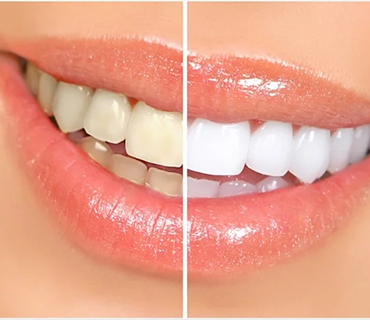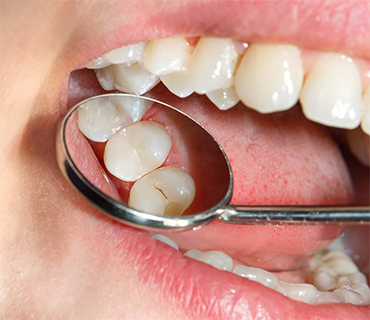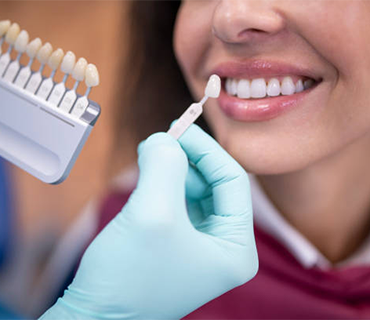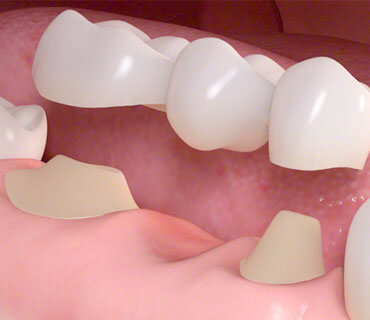Our Services
All these services are rendered to enable patients enjoy a healthy life style where they feel no hesitationin displaying their beautiful smile

Dental Hygiene
The oral hygiene you practice at home—brushing at least two times a day and flossing every day—is great for keeping your smile healthy and beautiful between visits to your dentist, but it doesn’t take the place of the more in-depth cleaning we’re able to perform at Inova Dental. Here, not only can we perform more comprehensive cleaning, but we can also perform fluoride treatments, take actions to prevent or reverse gum disease.


Teeth Whitening
Teeth whitening is an increasingly popular procedure.
Dental whitening is a safe process that brightens the coloration of the enamel and dentin of teeth using a whitening solution that is carbamide peroxide or hydrogen peroxide. This solution will break the pigments that have formed over the years.
White teeth that make up a bright smile is a sign of beauty, health and youth.
If you want to restore radiance to your smile, it is best to discuss it with one of our dentists or hygienists. They will first clean your teeth and make sure, by means of a complete examination, that you do not have any cavities or defective restorations.
He can then determine why your teeth are not as white as they used to be, a crucial step in the success of the treatment.
Several causes can be at the origin of a change in tooth color:
First of all, the teeth can be covered with a build-up of dental plaque and tartar. These deposits become colored if a person drinks coffee, tea, red wine frequently. A simple cleaning and polishing of the teeth is enough to remove superficial stains, but not when the stain is lodged in the enamel and in the dentin of the teeth.
The possible causes can be natural aging of the teeth, decay, the consumption of tobacco products, certain medications or too much fluoride at a young age.
Some facts :
- Some people respond better to whitening treatment than others.
Those with yellowish-colored teeth usually respond better than those with brownish-colored teeth. - Sometimes the teeth have a grayish color, which results from taking tetracycline at a young age to treat certain childhood illnesses or from taking minocycline used by adolescents and young adults to treat acne problems. These stains are more resistant to bleaching and in some cases it is unfortunately not possible to remove them completely.
- In addition, people whose anterior teeth have been restored with dental materials that have changed color over time will need to change them in order to have teeth of the same color.
The dentist insulates the teeth and protects the gums using a protective gel or a rubber dam.

Children's Dentistry
The child’s first visit to the dental office is of paramount importance. It is for this reason, your dentist recommends systematic visits from the age of 3 so that this first contact does not occur in an emergency or in pain. This first visit to the dental clinic will often condition the future relationship with the dentist. During this first meeting, we will be able to inform the parents and educate the child to put in place from an early age the gestures and behaviors necessary for good dental health.
THE MINOR INCONVENIENCES OF TOOTH ERUPTION
The appearance of the first teeth can be accompanied by unpleasant manifestations such as hyperthermia, hyper salivation, small perioral irritations, diarrhea, etc. It generally begins between 4 and 8 months with the appearance of the lower incisors and continues until 30 months with the eruption of the 1st molars around 18 months, of the canines around 2 years old and finally molars around 3 years old.
IMPORTANCE OF FURROW SEALS
Furrow sealing is indicated to prevent the appearance of decay on permanent molars and has largely made its first in the last twenty years. This quick and painless technique involves filling in furrows using a fluid resin. This prevention technique is indicated for children from 6 years old and adolescents.

AT EACH AGE, ITS TYPE OF BRUSHING!
Before 3 years old: parents must first clean their teeth using a wet compress and then as soon as the molars appear using a very soft baby toothbrush.
After 3 years: The child begins to brush his teeth, it is desirable that this be done in the presence of the parents so that they can guide him or complete the brushing so that no area is forgotten.
Warning! around 6 years the permanent molars appear, they must be given great vigilance because of their high susceptibility to decay.
Around 8, 9 years old: Children must become independent and learn to take care of their teeth on their own. The brushing method he will use throughout his life can be taught to him at this age.
TOOTH SEALANTS
If a child has deep pits and grooves in their baby (primary) teeth, a sealant might be placed to prevent tooth decay. However, sealants are usually not placed on permanent teeth because they aren’t strong enough.

FLUORIDE TREATMENT
Since the introduction of fluoride, there has been a decrease in dental caries in children and adults.
Topical fluoride treatment is best for children between 3 and 6 years of age. This type of fluoride comes in a few different forms, including:
Self-applied fluoride toothpaste
Professionally applied treatments, such as gels, pastes, and varnishes
Topical fluoride treatments are applied during professional teeth cleanings and help prevent cavities.

Composite / White Fillings
To treat a cavity your dentist will remove the decayed portion of the tooth and then fill the area on the tooth where the decayed material was removed. Fillings are also used to repair cracked or broken teeth and teeth that have been
worn down from misuse (such as from nail-biting or tooth grinding). Teeth can be filled with tooth-colored, plastic, and materials called composite resin fillings. The location and extent of the decay, cost of filling material, your insurance
coverage, and your dentists recommendation assist in determining the type of filling best for you.

Dental Veneers
Dental veneers (sometimes called porcelain veneers or dental porcelain laminates) are wafer-thin, custom-made shells of tooth-colored materials designed to cover the front surface of teeth to improve your appearance. These shells are bonded to the front of the teeth changing their color, shape, size, or length.
Dental veneers can be made from porcelain or from resin composite materials. Porcelain veneers resist stains better than resin veneers. They also better mimic the light-reflecting properties of natural teeth. You will need to discuss the best choice of veneer material for you with your dentist.

Crowns
If your tooth is damaged but not lost, a crown can be used to restore its shape, appearance and function. You may need a crown if you have a root canal, a large filling in a tooth or a broken tooth.
A crown, also called a cap, is a hollow, artificial tooth used to cover a damaged or decayed tooth. The crown restores the tooth and protects it from further damage. Crowns can also be used to cover a discoloured or misshapen tooth. A tooth that has been fixed with a crown looks and works very much like a natural tooth.
How a crown is done
These are the steps dentists most often follow in making a crown, but your tooth may need special care. You may need orthodontic treatment, gum treatment or root canal treatment. It may take more than 2 visits to your dentist, or your visits may last longer.

DIFFERENT TYPES OF CROWNS
Crowns are made from various types of materials. Depending on which tooth needs a crown, your dentist will suggest a material, or combination of materials, that is right for you.
Metal crowns are made of gold. They generally last a long time and won’t chip or break. They tend not to wear down your opposing natural teeth. However, the gold colour does not look natural, particularly on front teeth.
Porcelain crowns look the most natural. They are more brittle than metal or composite and may chip more easily. Because of this, they are not usually placed on back teeth.
Porcelain-fused-to-metal crowns look natural and are stronger than porcelain or composite crowns. They won’t chip as easily as porcelain or ceramic crowns. However, depending on their design, the metal may show if your gums are thin or shrink.

